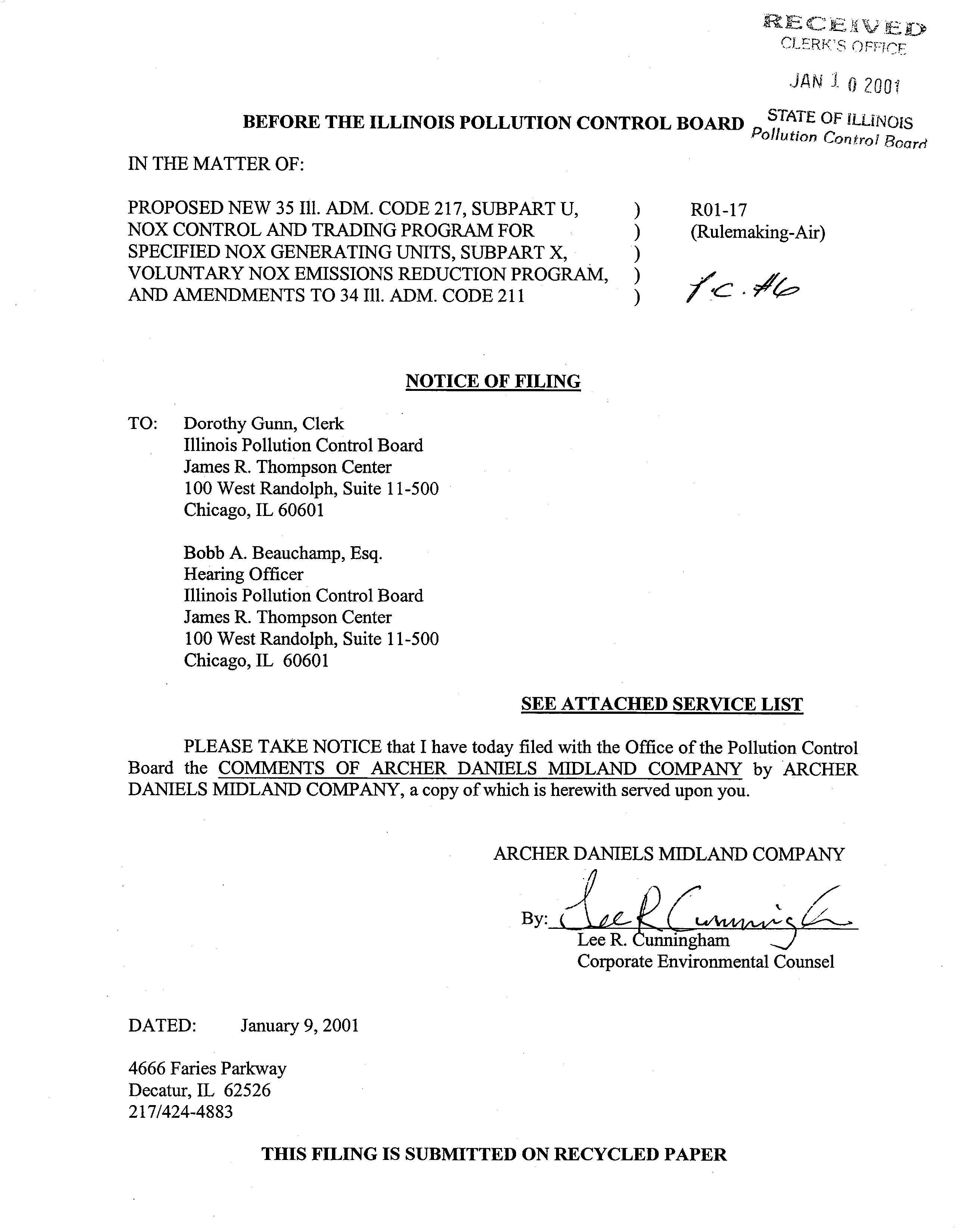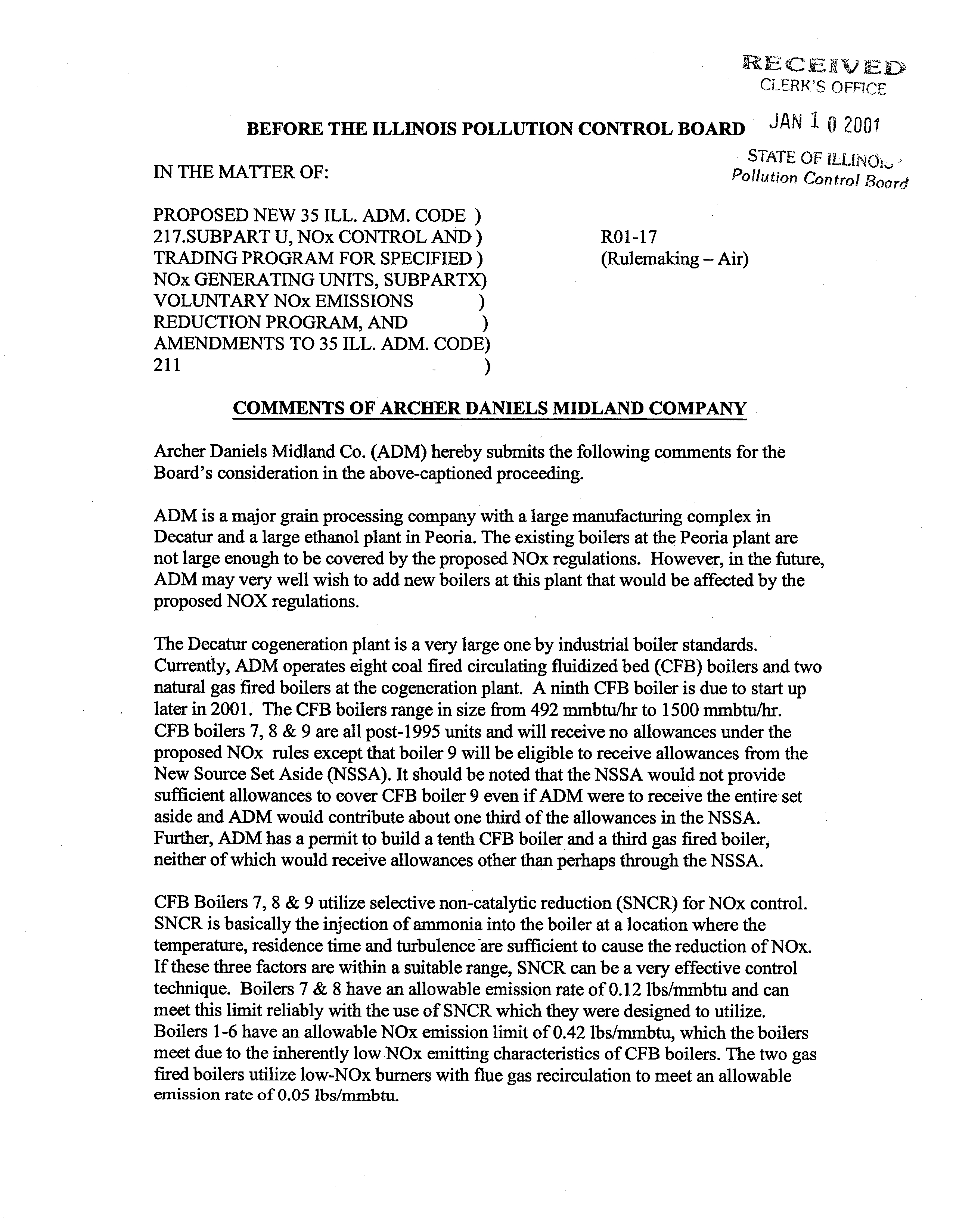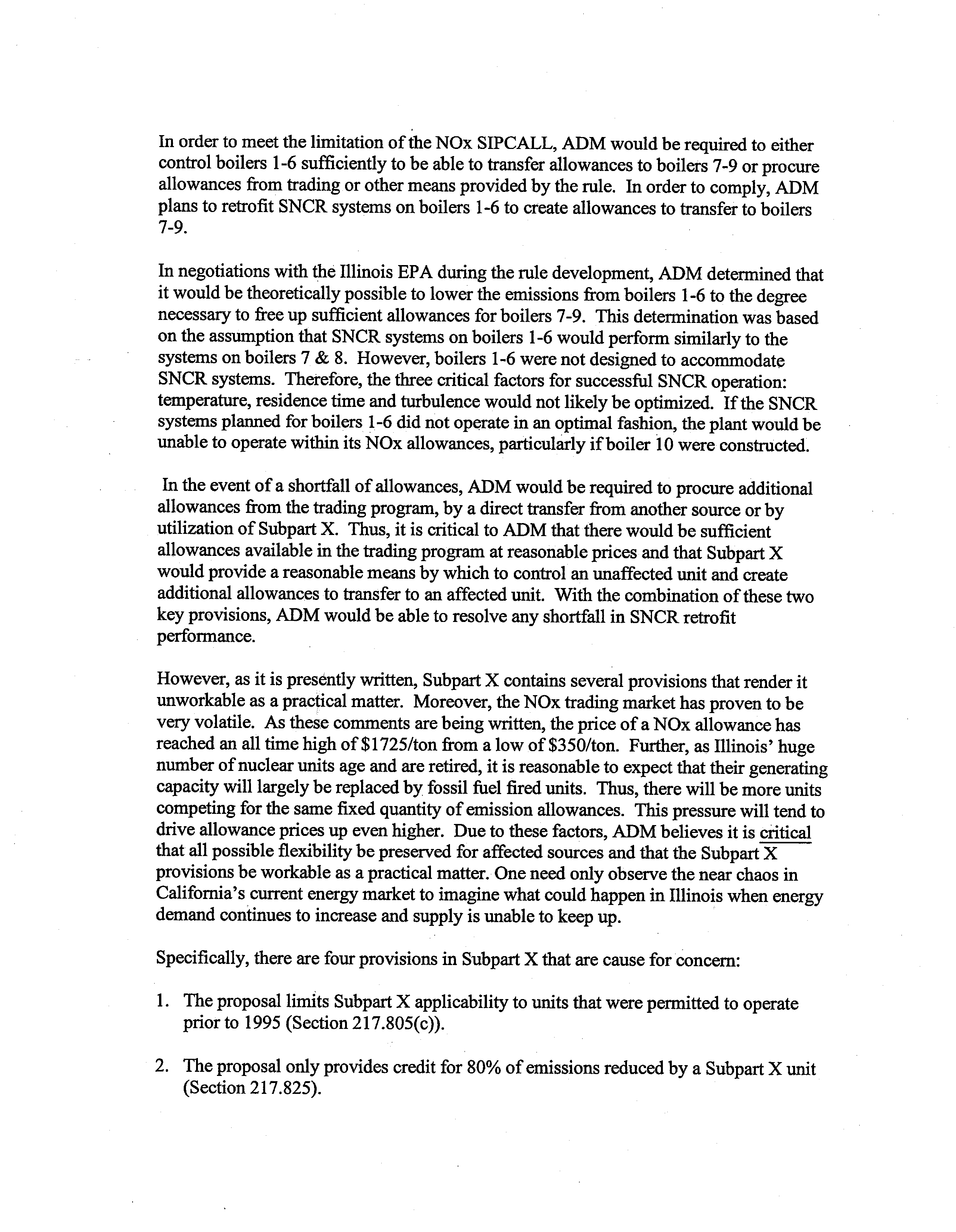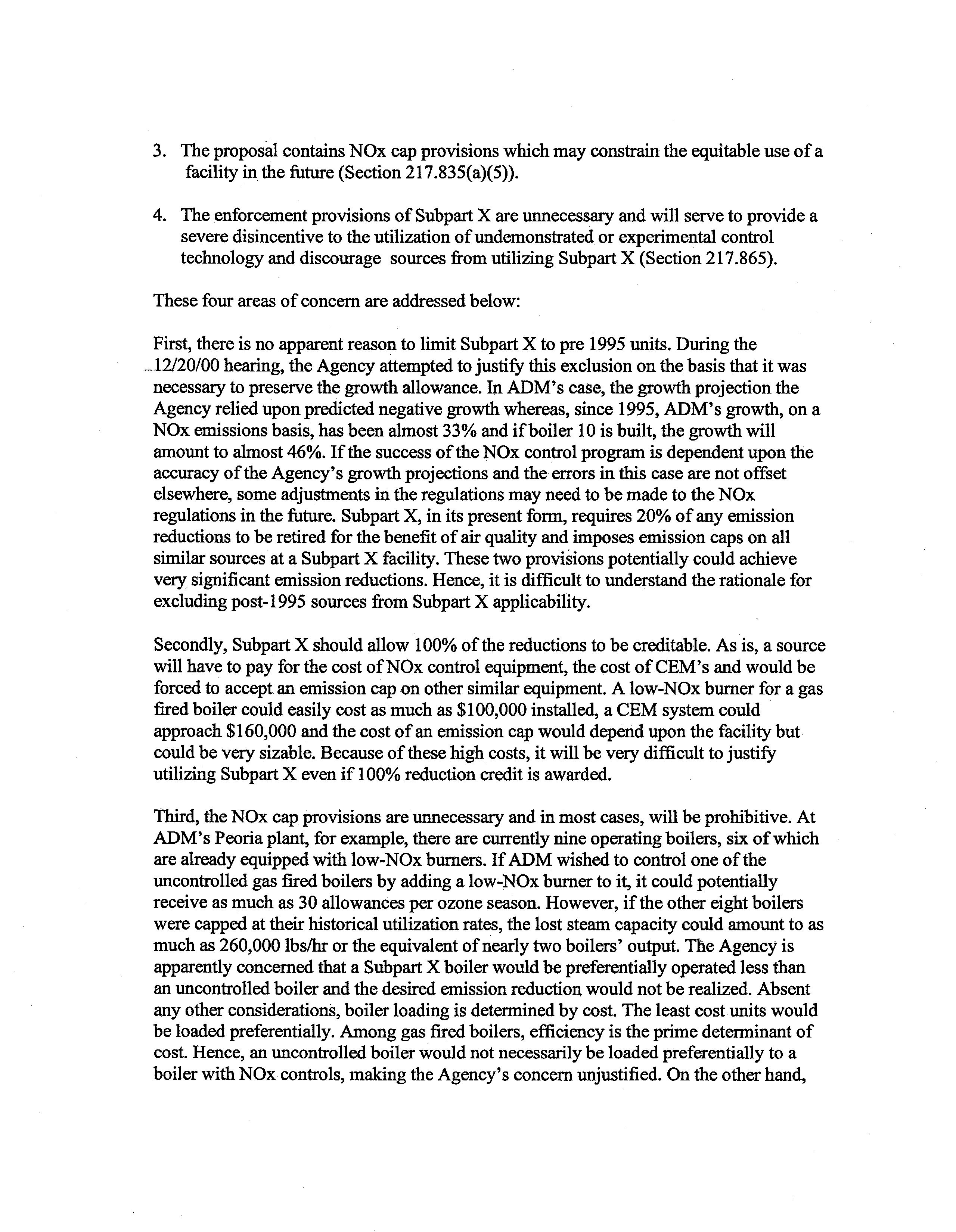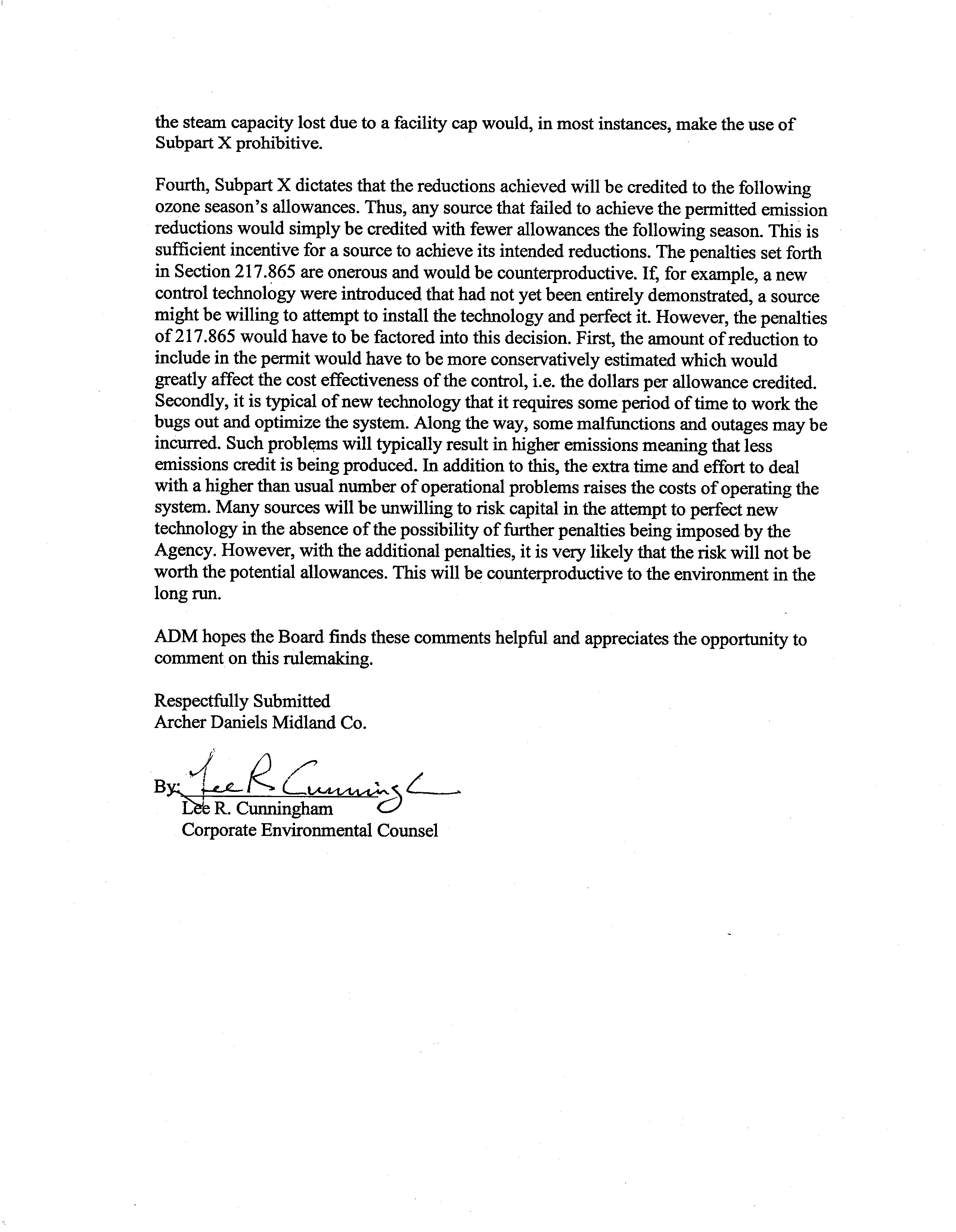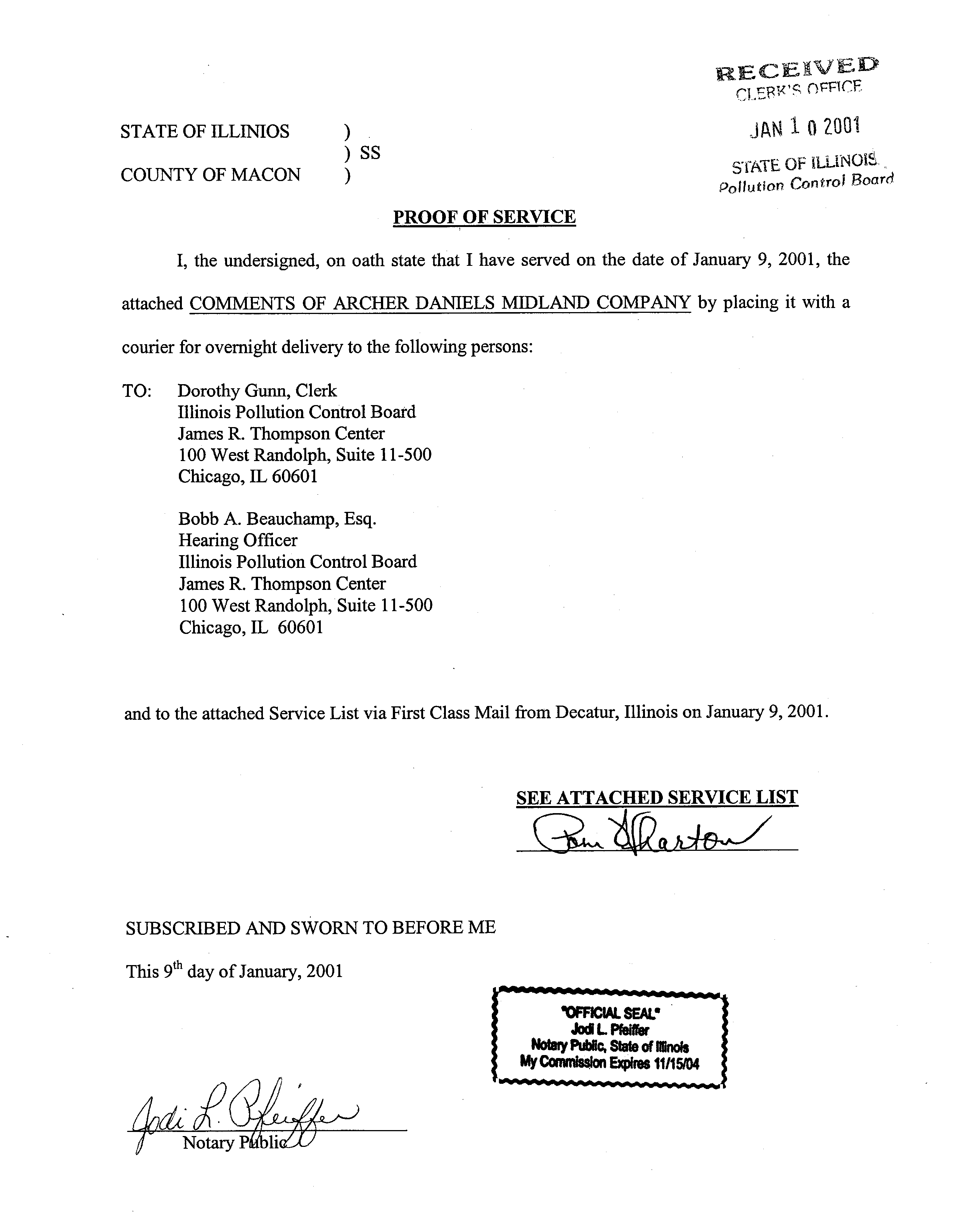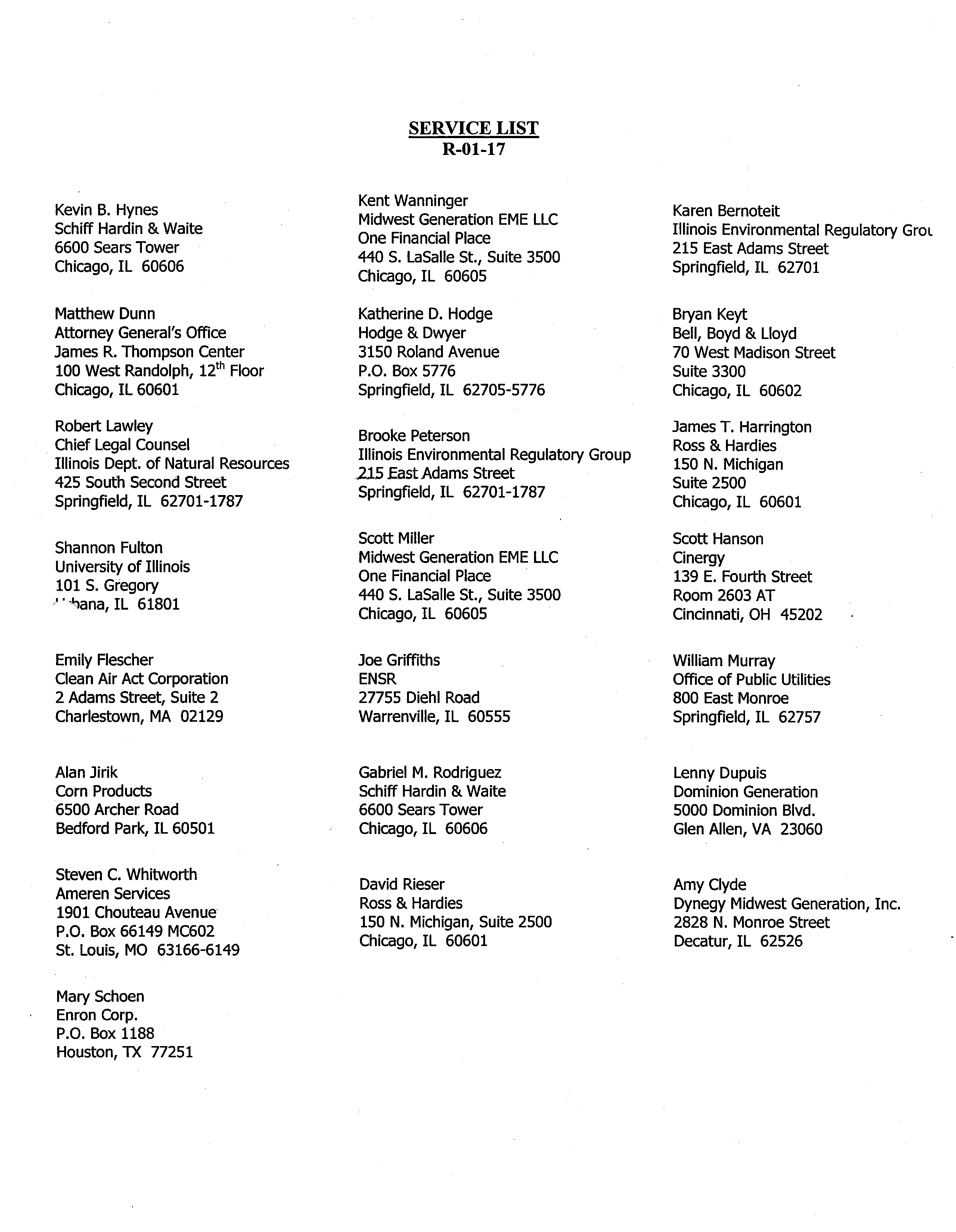CLER
~~r~r~
,~-
JJ~N
3
~
STATE OF
ILLINOIS
BEFORE THE ILLINOIS POLLUTION CONTROL BOARD
~
Control
Bcari~
IN THE MATTER OF:
PROPOSED NEW
35
Ill. ADM. CODE 217, SUBPART U,
)
R01-17
NOX CONTROL AND TRADING PROGRAM FOR
)
(Rulemaking-Air)
SPECIFIED NOX GENERATING UNITS, SUBPART X,
)
VOLUNTARY NOX EMISSIONS REDUCTION PROGRAM,
)
AND AMENDMENTS TO 34111. ADM. CODE 211
)
NOTICE OF FILING
TO:
Dorothy Gunn, Clerk
Illinois Pollution Control Board
James R. Thompson Center
100 West Randolph, Suite 11-500
Chicago, IL 60601
Bobb A. Beauchamp, Esq.
Hearing Officer
Illinois
Pollution Control Board
James R.
Thompson Center
100 West Randolph, Suite 11-500
Chicago, IL
60601
SEE
ATTACHED SERVICE LIST
PLEASE TAKE NOTICE that I have today filed with the Office of the Pollution Control
Board
the
COMMENTS
OF
ARCHER
DANIELS
MIDLAND
COMPANY
by
ARCHER
DANIELS MIDLAND COMPANY, a copy ofwhich is herewith served upon you.
ARCHER DAMELS MIDLAND COMPANY
/
~
/7
By:
Lee R.
unningham
Corporate Environmental Counsel
DATED:
January 9,2001
4666 Faries Parkway
Decatur, IL
62526
217/424-4883
THIS FILING IS
SUBMITTED ON RECYCLED PAPER
CLERR’s OFFICE
BEFORE THE ILLINOIS POLLUTION CONTROL BOARD
~
1
0
2001
STATE
OF ILLI;
Oi~.
IN THE MATTER OF:
POIIiit
ion
Con tral Board
PROPOSED NEW 35 ILL. ADM. CODE)
217.SUBPART U, NOx CONTROL AND)
RO1-17
TRADING PROGRAM FOR SPECIFIED)
(Rulemaking
-
Air)
NOx GENERATING UNITS, SUBPARTX)
VOLUNTARY NOx EMISSIONS
)
REDUCTION PROGRAM, AND
)
AMENDMENTS TO 35 ILL. ADM. CODE)
211
)
COMMENTS OF ARCHER DANIELS MIDLAND COMPANY
Archer Daniels
Midland Co. (ADM) hereby submits the following
comments forthe
Board’s consideration in the above-captioned proceeding.
ADM is a major grain processing company with a largemanufacturing complex in
Decatur and a large ethanol plant in Peoria. The existing boilers at the Peoria plant are
not large enough to be covered by the proposed NOx regulations.
However, in the future,
ADM may very well wish to
add new boilers at this plant that would be affected by the
proposed NOXregulations.
The Decatur cogeneration plant is a very large one by industrial boiler standards.
Currently, ADM operates eight coal fired circulating fluidizedbed (CFB) boilers and two
natural gas fired boilers at the cogenerationplant.
A ninth CFB boiler is due to start up
later in 2001.
The CFB boilers rangein size from 492 mmbtu/hr to
1500 mmbtu/hr.
CFB boilers 7,
8
&
9 are all post-1995 units and will receive no allowances under the
proposedNOx
rules except that boiler 9 will be eligible
to receive allowances from the
New Source Set Aside (NSSA). It should be noted that the NSSA would not provide
sufficient allowances to cover CFB boiler 9 even if ADM were to receive the entire set
aside and ADM would contribute about one third ofthe allowances in the NSSA.
Further, ADM has a permit to build a tenth CFB boiler and a third gas fired boiler,
neither ofwhich would receive allowances other than perhaps through theNSSA.
CFB Boilers 7,
8 & 9 utilize selective non-catalytic reduction (SNCR) forNOx control.
SNCR is basically the injection ofammonia into the boiler at a location where the
temperature, residence time and turbulence are sufficient to
cause the reduction ofNOx.
Ifthese three factors are within a suitable range, SNCR can be a very effective control
technique.
Boilers 7
& 8 have an allowable emission rate of 0.12 lbs/mmbtu and can
meet this limit reliably with the use ofSNCR which they were designed to utilize.
Boilers 1-6 have an allowable NOx emission limit of0.42 lbs/mmbtu, which theboilers
meet due to the inherently low NOx emitting characteristics ofCFB boilers. The two gas
fired boilersutilize low-NOx burners with flue gas recirculation to meet an allowable
emission rate of
0.05 lbs/nimbtu.
In order to meet the limitation ofthe NOx SIPCALL, ADM would be required to either
control boilers 1-6 sufficiently to be ableto transfer allowances to boilers 7-9 or procure
allowances from trading or other means provided by the rule.
In order to comply, ADM
plans to retrofit SNCR systems
on boilers
1-6 to create allowances to transferto boilers
7-9.
In negotiations with the Illinois EPA during the rule development, ADM determined that
itwould be theoreticallypossible to lower the emissions from boilers 1-6 to the degree
necessary to free up sufficient allowances forboilers 7-9.
This determination was based
on the assumption that SNCR systems on boilers
1-6 would perform similarly to
the
systems on boilers 7
& 8.
However, boilers
1-6 were not designed to accommodate
SNCR systems.
Therefore, the three critical factors for successful SNCR operation:
temperature, residence time and turbulence would not likely be optimized.
Ifthe SNCR
systems planned forboilers
1-6 did not operate in an optimal fashion, theplant would be
unable to operate withinits NOx allowances, particularly if boiler 10 were constructed.
Inthe event ofa shortfall ofallowances,
ADM would be required to procure additional
allowances from the trading program, by a direct transfer from another source orby
utilization of Subpart X.
Thus, it is critical to ADM that there would be sufficient
allowances available in the trading program at reasonable prices and that Subpart X
would provide a reasonable means by which to control an unaffected unit and create
additional allowances to
transfer to an affected unit.
With the combination ofthese two
key provisions, ADM would be able to resolve any shortfall in SNCR retrofit
performance.
However, as it is presently written, Subpart X contains several provisions that render it
unworkable as a practical matter.
Moreover, the NOx trading market hasproven to be
very volatile.
As these comments are beingwritten, the price of a NOx allowance has
reached an all time high of$1725/ton from a low of $350/ton.
Further, as illinois’ huge
number ofnuclear units age and are retired, it is reasonable to expect that their generating
capacity will largely be replaced by fossil fuel fired units.
Thus, there willbe moreunits
competing forthe same fixed quantity ofemission allowances.
This pressurewill tend to
drive allowance prices up even higher.
Due to these factors, ADM believes it is
critical
that all possible flexibility be preserved for affected sources and that the Subpart X
provisions be workable as a practical matter. One need only observe thenear chaos in
California’s
current energy market to
imaginewhat could happen in Illinois when energy
demand continues to increase and supply is unable to keep up.
Specifically, there are four provisions in Subpart X that are cause for concern:
1.
The proposal limits Subpart X applicability to units that were permitted to operate
prior to
1995 (Section2 17.805(c)).
2.
The proposal only provides credit for 80
ofemissions reducedby a Subpart X unit
(Section 217.825).
3.
The proposal contains NOx cap provisions which may constrain the equitable use of a
facility in the future (Section 217.835(a)(5)).
4.
The enforcement provisions ofSubpart X are unnecessary and will serve to provide a
severe disincentive to the utilizationofundemonstrated or experimental control
technology and discourage
sources from utilizing Subpart X (Section 2 17.865).
These four areas ofconcern are addressed below:
First, there is no apparent reason to limit Subpart X to pre
1995 units. During the
A2/20/00 hearing, the Agency attempted to justify this exclusion on the basis that it was
necessary to
preserve the growth allowance. InADM’s case, the growth projection the
Agency relied upon predicted negative growth whereas, since 1995, ADM’s growth, on a
NOx emissions basis, has been almost 33
and if boiler
10
is built, the growth will
amount to almost 46.
Ifthe success ofthe NOx control program is dependent upon the
accuracy oftheAgency’s growth projections and the errors in this case are not offset
elsewhere, some adjustments in theregulations may need to be made to theNOx
regulations in the future. Subpart X, in its present form, requires 20
ofany emission
reductions to be retired for thebenefit ofair quality and imposes emission caps on all
similar sources at a Subpart X facility. These two provisions potentially could achieve
very significant emission reductions. Hence, it is difficult to understand the rationale for
excluding post-1995 sources from Subpart X applicability.
Secondly, Subpart X should allow
100
ofthe reductions to be creditable. As is, a source
will have to pay forthe cost ofNOx control equipment, the cost ofCEM’s and would be
forced to
accept an emission cap on other similar equipment. A low-NOx burner for a gas
fired boiler could easily cost as much as $100,000 installed, a CEM system could
approach $160,000 and the cost ofan emission cap would depend upon the facility but
could be very sizable. Because ofthese high costs, it will be very difficult to justify
utilizing Subpart X even if 100
reduction credit is awarded.
Third, the NOx cap provisions areunnecessary and in most cases, will be prohibitive. At
ADM’s Peoria plant, for example, thereare currently nine operating boilers, six ofwhich
are already equipped with low-NOx burners. IfADM wished to control one ofthe
uncontrolled gas fired boilersby adding a low-NOx burner to it, it could potentially
receive as much as 30 allowances per ozone season. However, ifthe other eight boilers
were capped at theirhistorical utilization rates, the lost steam capacity could amount to
as
much as 260,000 lbs/hr or the equivalent ofnearlytwo boilers’ output. The Agency is
apparently concerned that a Subpart X boiler would be preferentially operated less than
an uncontrolled boiler and the desired emission reduction would not be realized. Absent
any other considerations, boiler loading is determinedby cost. The least cost units would
be loaded preferentially. Among gas tired boilers, efficiency is the prime determinant of
cost. Hence, an uncontrolled boilerwould not necessarily be loaded preferentially to a
boiler with NOx controls, making the Agency’s concern unjustified. On the other hand,
the steam capacity lost due to a facility cap would, in most instances, make the use of
Subpart X prohibitive.
Fourth, Subpart X dictates that the reductions achieved will be credited to
the following
ozone season’s allowances. Thus, any source that failed to achieve the permitted emission
reductions would simplybe credited with fewer allowances the following season. This is
sufficient incentive for a source to achieve its intended reductions. The penalties set forth
in Section 217.865 are onerous and would be counterproductive. If, for example, a new
control technology were introduced that had not yet been entirelydemonstrated, a source
might be willing to attempt to install the technology and perfect it. However, the penalties
of217.865 would have to be factored into this decision. First,
the amount ofreduction to
include in the permit would have to be more conservatively estimated which would
greatly affect the cost effectiveness ofthe control, i.e. the dollars per allowance credited.
Secondly, it is typical ofnew technology that it requires some period oftime to work the
bugs out and optimize the system. Along the way, some malfunctions and outages maybe
incurred. Such problems will typically result in higher emissions meaning that less
emissions
credit is being produced. In addition to
this, the extratime and effort to deal
with a higherthan usual number of operational problems raises the costs ofoperating the
system.
Many sources will be unwilling to risk capital in the attempt to perfect new
technology in the absence ofthe possibility offurther penalties being imposed by the
Agency. However, with the additional penalties, it is very likely that the risk will not be
worth the potential allowances. This will be counterproductive to the environment in the
long run.
ADM hopes the Board finds these comments helpful and appreciates the opportunity to
comment on this rulemaking.
Respectfully Submitted
Archer Daniels Midland Co.
Corporate Environmental Counsel
RE C ~i
cp~V~
C~RCF
STATE OF ILLINIOS
)
J!\N
1
0
2001
COUNTY OF MACON
)
S1~TL
Control
j3oard
PROOF OF SERVICE
I, the undersigned, on oath
state that I have served
on the date of January
9,
2001,
the
attached COMMENTS
OF
ARCHER DANIELS
MIDLAND
COMPANY by
placing
it with
a
courier for overnight delivery to the followingpersons:
TO:
Dorothy Gunn, Clerk
Illinois Pollution Control Board
James R. Thompson Center
100 West Randolph, Suite 11-500
Chicago, IL 60601
Bobb A. Beauchamp, Esq.
Hearing Officer
Illinois Pollution Control Board
James R. Thompson Center
100 West Randolph, Suite 11-500
Chicago, IL
60601
and to the attached Service List via First Class Mail
from Decatur, Illinois on January 9,
2001.
SEE ATTACHED SERVICE LIST
SUBSCRIBED AND SWORN TO BEFORE ME
This
9th
day ofJanuary, 2001
(I5a~
‘OFFICIAL SEAL
JOiLPhWU
NotatyPubic, State of Enols
MvCommiuionExpfrog
11115104
J
Notary Phhlin=-LI
SERVICE LIST
R-O1-17
Kevin
B.
Hynes
Schiff Hardin & Waite
6600 Sears Tower
Chicago, IL
60606
Matthew Dunn
Attorney General’s Office
James
R. Thompson Center
100 West Randolph,
12th
Floor
Chicago,
IL
60601
Robert Lawley
Chief Legal Counsel
Illinois Dept. of Natural
Resources
425 South Second Street
Springfield, IL
62701-1787
Shannon Fulton
University of Illinois
101
5. Gregory
“~ana,
IL
61801
Emily
Flescher
Clean Air Act Corporation
2 Adams
Street, Suite 2
Charlestown,
MA
02129
Alan Jirik
Corn Products
6500 Archer Road
Bedford
Park,
IL
60501
Steven
C. Whitworth
Ameren
Services
1901 Chouteau Avenue
P.O. Box66149 MC602
St. Louis, MO 63166-6149
Kent Wanninger
Midwest Generation
EME LLC
One
Financial
Place
440
5.
LaSalle
St.,
Suite 3500
Chicago, IL
60605
Katherine
D.
Hodge
Hodge & Dwyer
3150 RolandAvenue
P.O. Box 5776
Springfield, IL
62705-5776
Brooke
Peterson
Illinois Environmental Regulatory
Group
Z15 East Adams
Street
Springfield, IL
62701-1787
Scott Miller
Midwest Generation
EME
LLC
One Financial
Place
440 5.
LaSalle
St., Suite 3500
Chicago, IL
60605
Joe Griffiths
ENSR
27755 Diehl Road
Warrenville, IL
60555
Gabriel M.
Rodriguez
Schiff
Hardin
& Waite
6600 Sears Tower
Chicago, IL 60606
David Rieser
Ross &
Hardies
150
N.
Michigan, Suite 2500
Chicago, IL
60601
Karen Bernoteit
Illinois Environmental Regulatory
Grot
215
East
Adams Street
Springfield, IL
62701
Bryan Keyt
Bell,
Boyd &
Lloyd
70 West Madison Street
Suite 3300
Chicago, IL
60602
James T.
Harrington
Ross & Hardies
150
N.
Michigan
Suite 2500
Chicago, IL 60601
Scott Hanson
Cinergy
139 E. Fourth Street
Room
2603 AT
Cincinnati,
OH
45202
William Murray
Office of Public
Utilities
800 East
Monroe
Springfield, IL
62757
Lenny Dupuis
Dominion Generation
5000
Dominion Blvd.
Glen Allen,
VA
23060
Amy Clyde
Dynegy Midwest Generation, Inc.
2828
N.
Monroe Street
Decatur, IL
62526
Mary Schoen
Enron Corp.
P.O. Box 1188
Houston,
TX
77251
